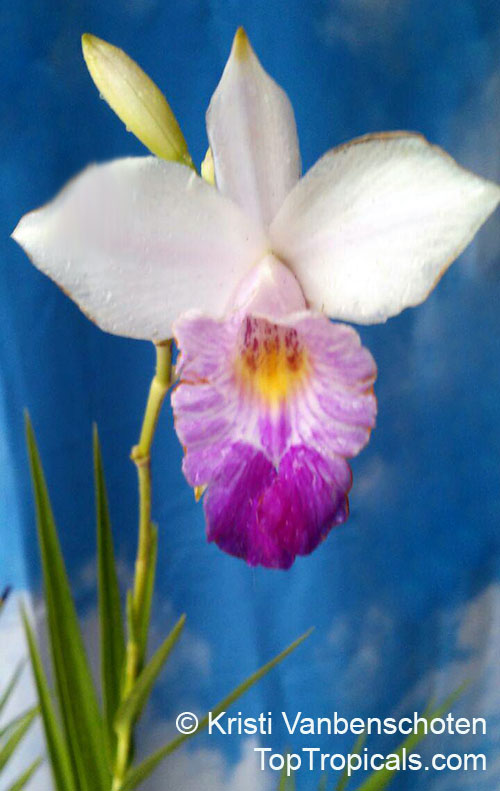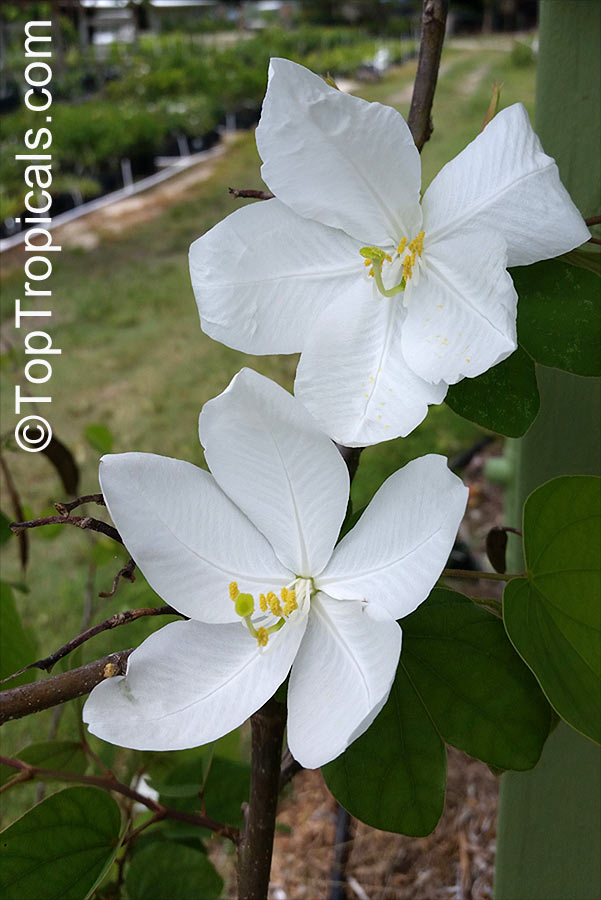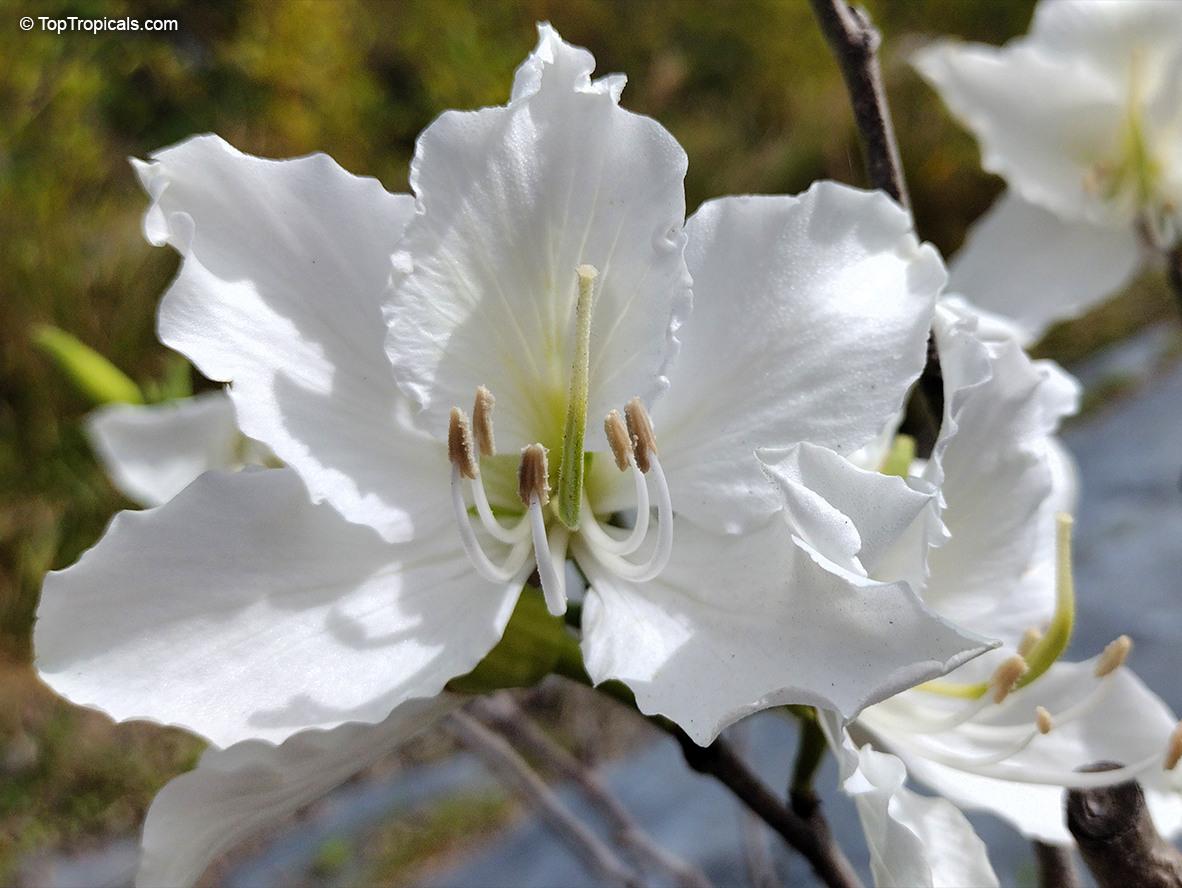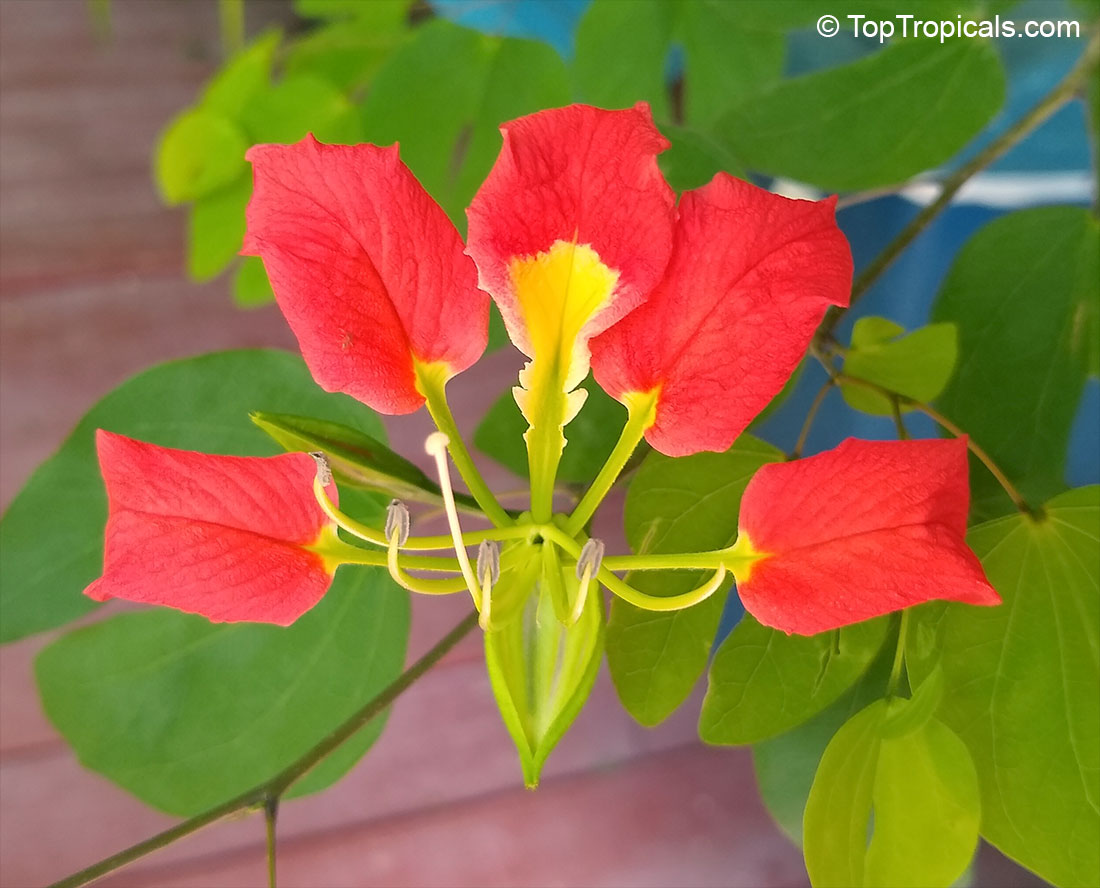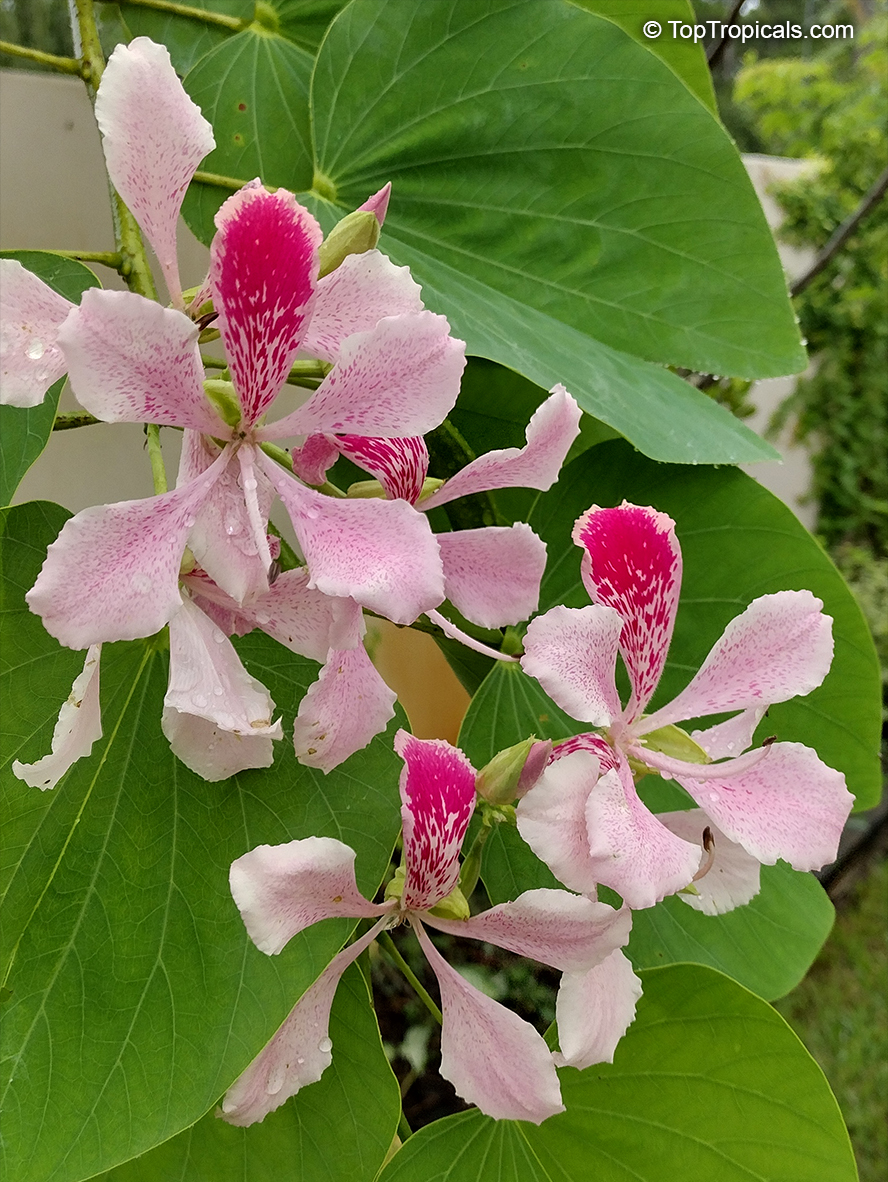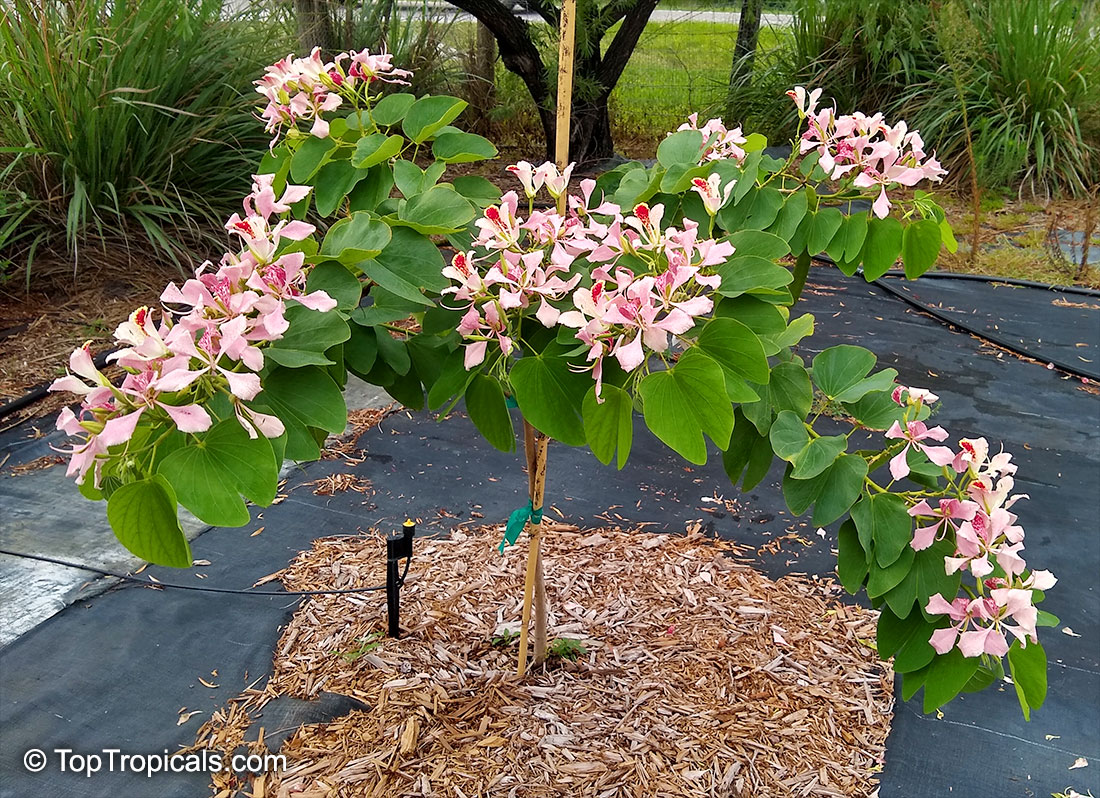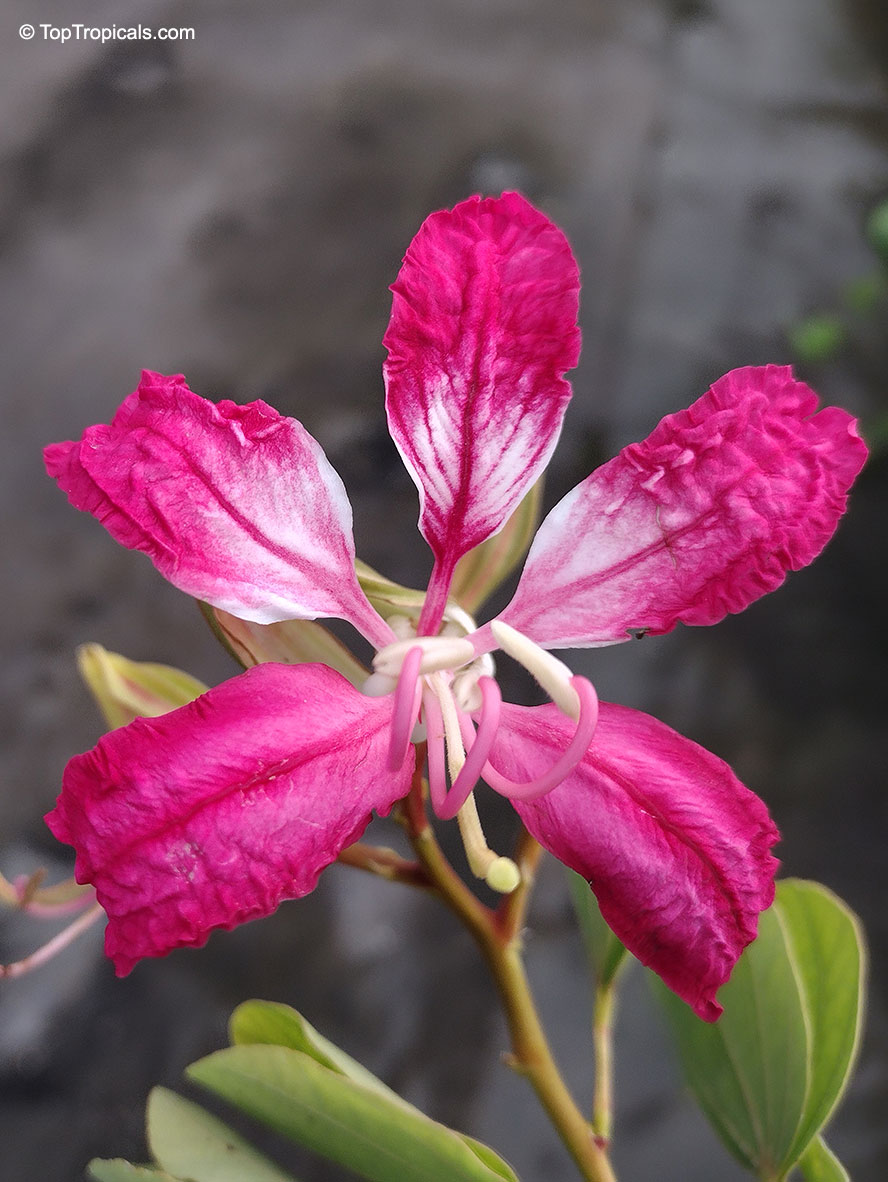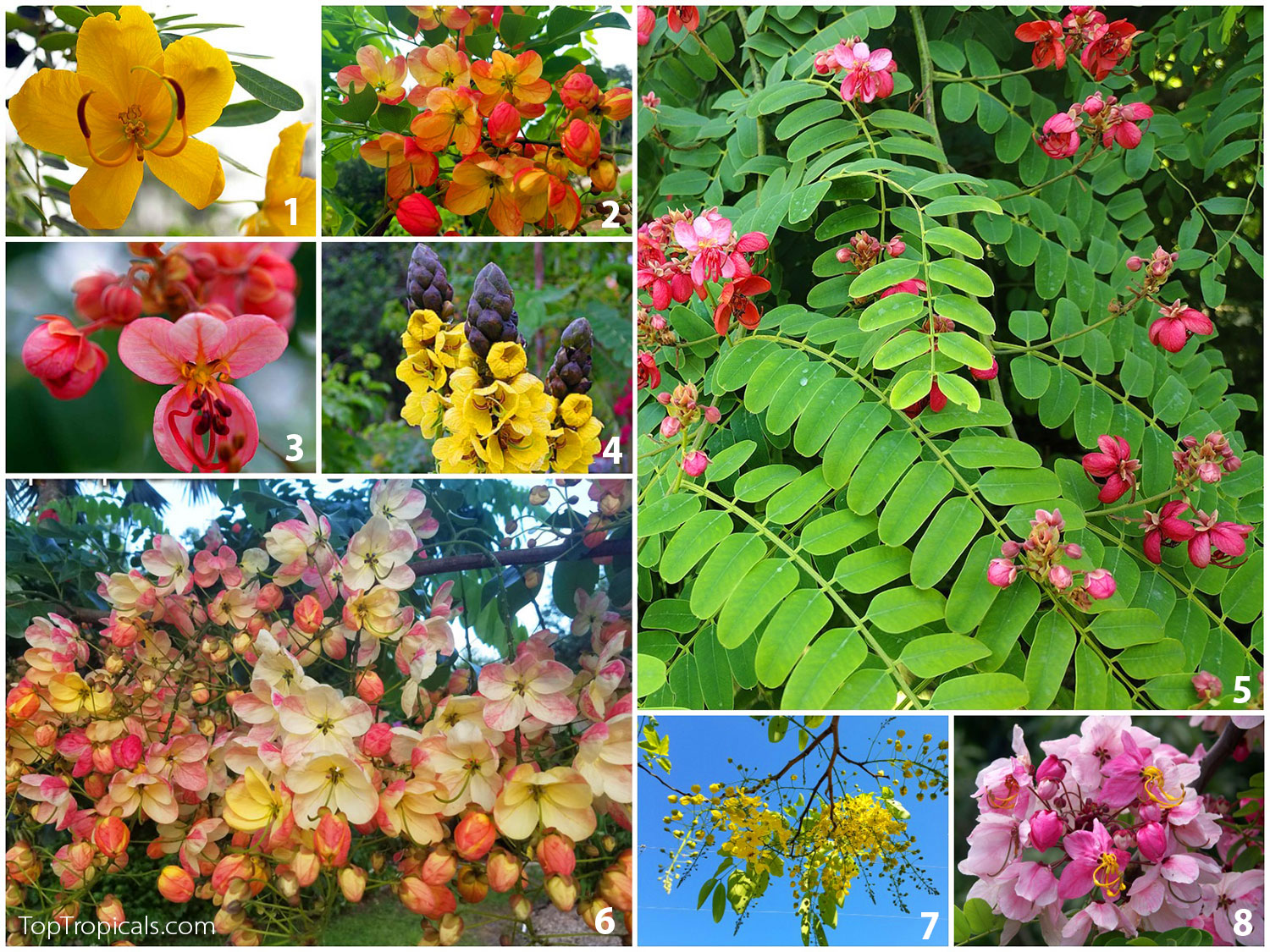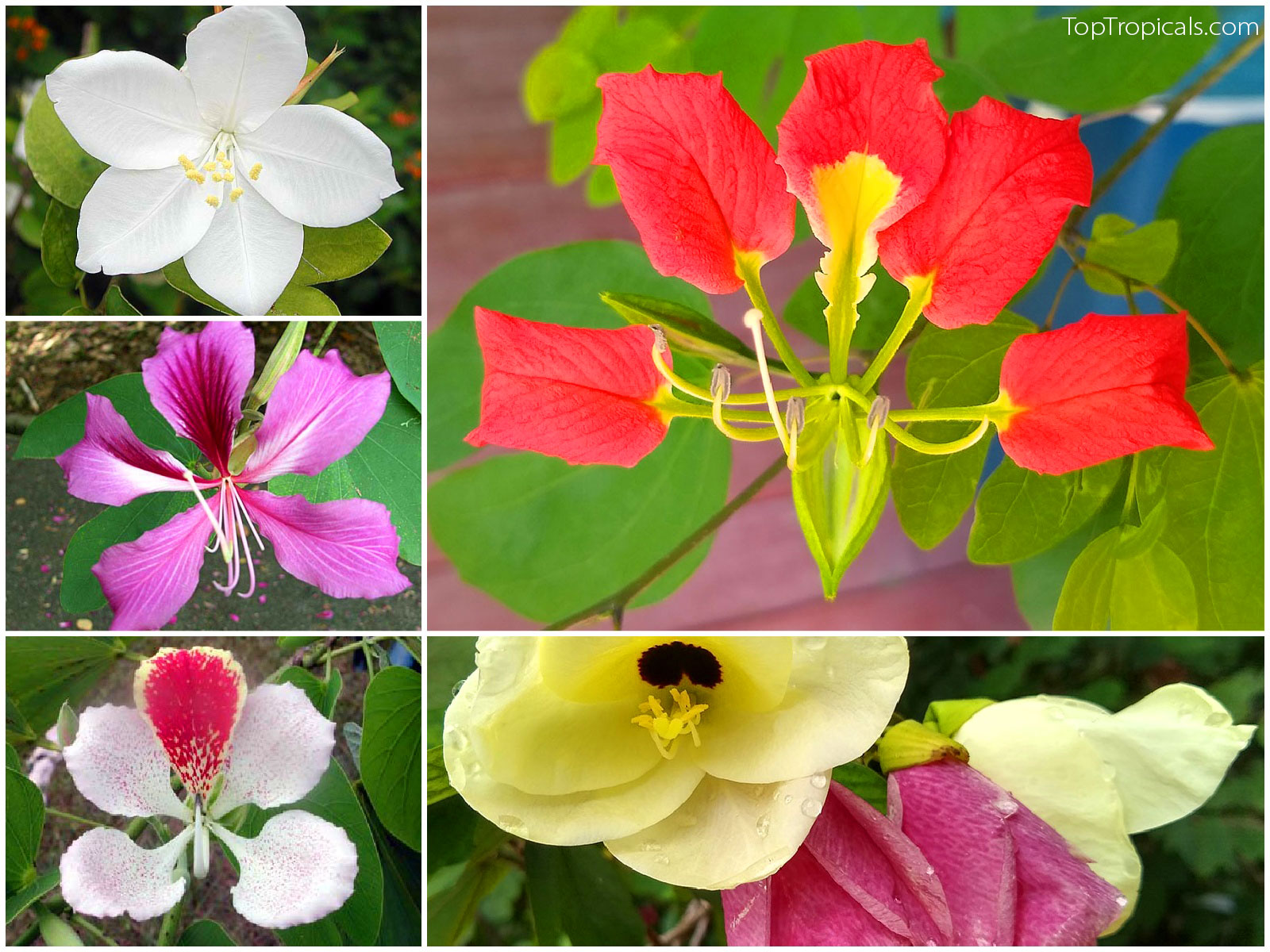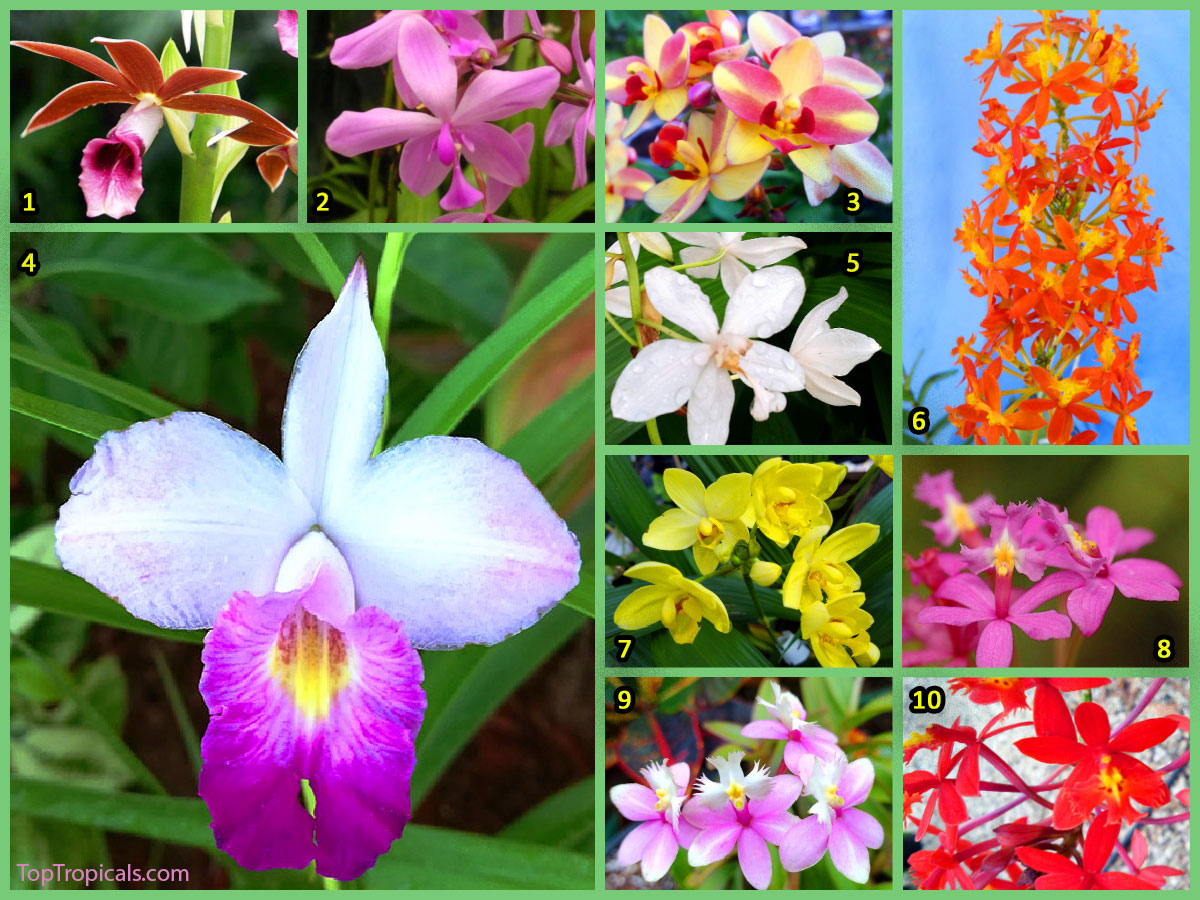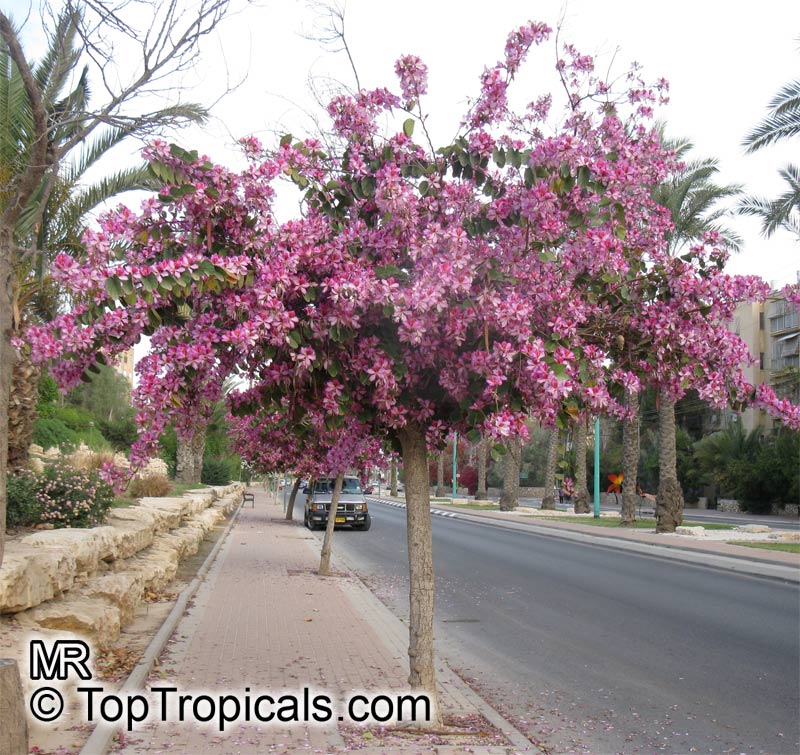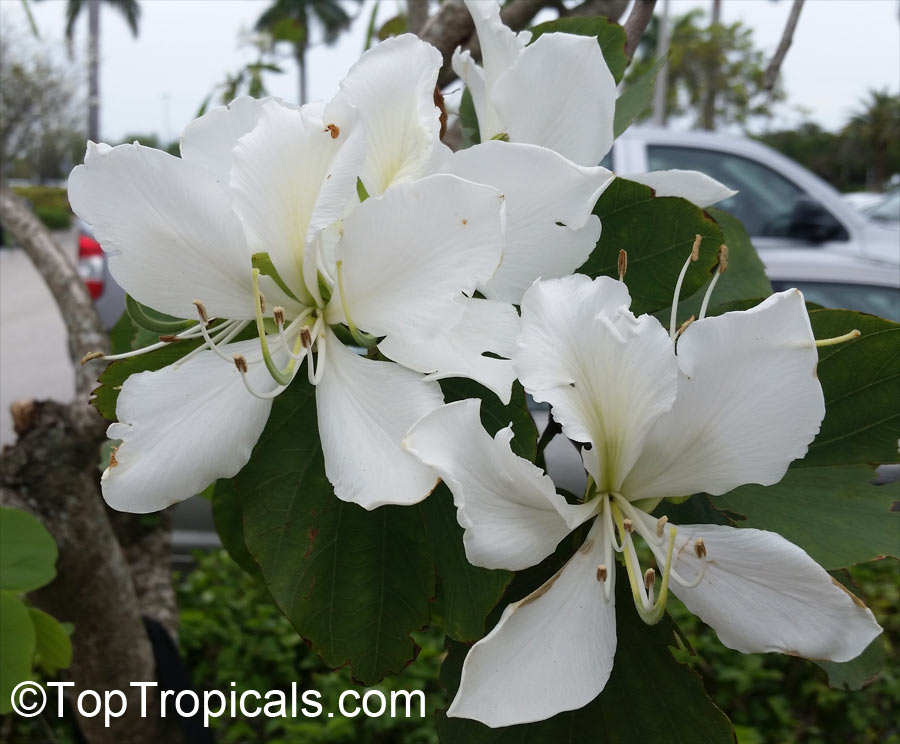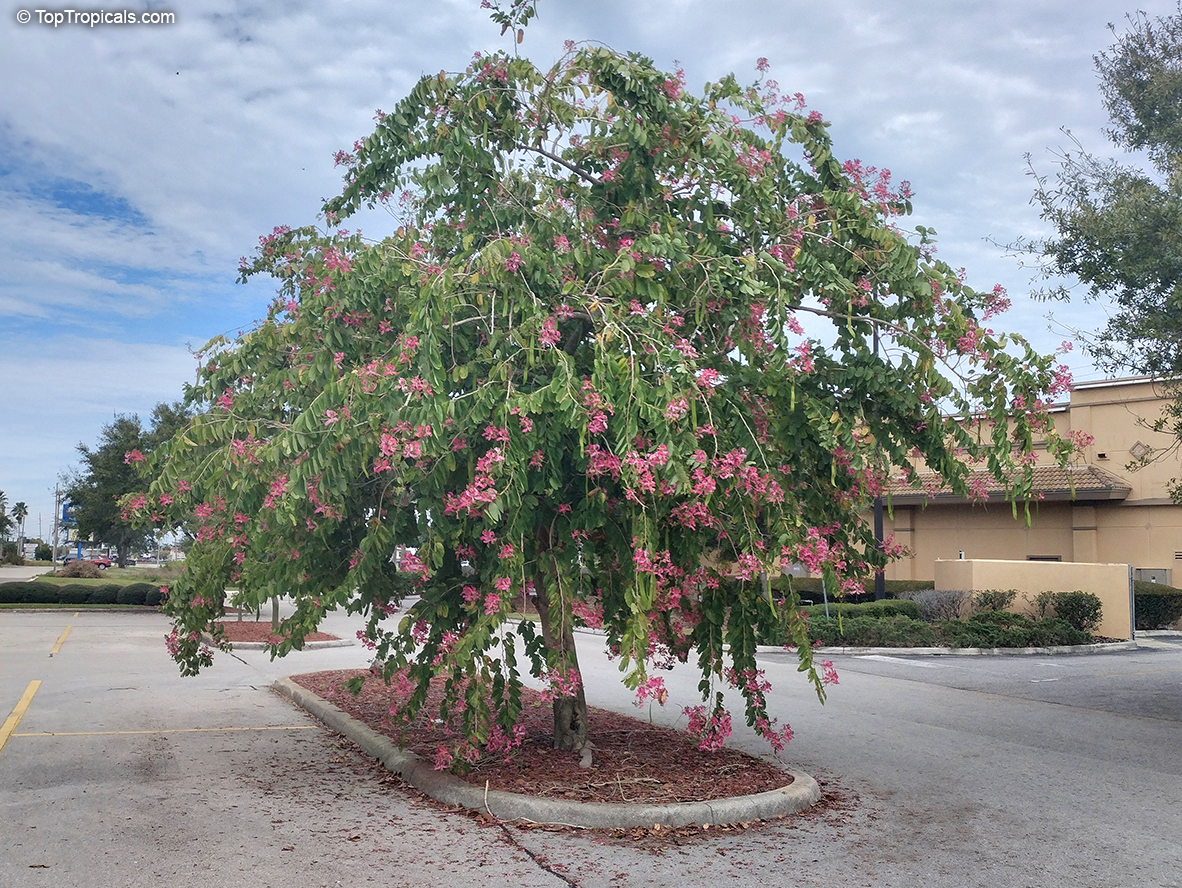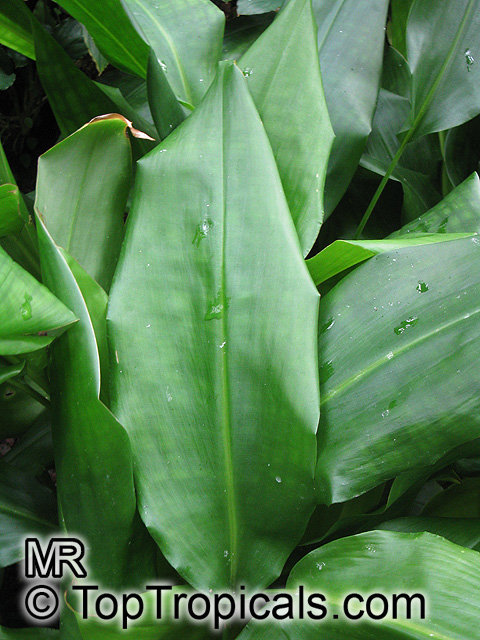






Last one
Date:
💞 Cassia or Bauhinia?
Looking for a small tree that blooms like fireworks but still fits on your patio? We hear this question all the time at Top Tropicals: Cassia or Bauhinia? Both are tropical showstoppers, but they shine in very different ways.
🌞 Cassias: Sunshine Fireworks
Cassia trees are some of the most rewarding tropical bloomers you can grow. Fast-growing, free-flowering, and surprisingly cold-tolerant, they thrive in full sun and summer heat. Their bright clusters come in shades of yellow, orange, pink, red, and even multicolor blends. The famous Rainbow Cassias show swirls of coral, gold, and rose on the same tree, creating a living fireworks display.
For gardeners in warm regions, these trees become spectacular focal points in the landscape. In containers, compact yellow forms like Cassia didymobotrya (Popcorn Cassia) and Senna alata (Empress Candles) stay manageable and bloom freely through summer.
Cassias can also be grown in pots with pruning and patience. Once mature, they reward you with breathtaking color that turns any patio or pool deck into a tropical show. Most showy cassias (numbers correspond to the photos in the collage above):
- Cassia bicapsularis (Butterfly Bush) - is a fast-growing, low-maintenance shrub covered in bright yellow, butterfly-like blooms from fall through winter.
- Cassia x natalensis (Rainbow Cassia)
- Cassia grandis (Red cassia) - a medium size tree having profuse blooms of dark pink to crimson flowers throughout the Spring.
- Cassia didymobotrya (Popcorn Cassia), small tree producing golden-yellow flowers with a distinct scent of peanut butter that open from brown buds in late summer and autumn. Similar to Senna alata (Empress Candles)
- Cassia roxburghii (Ceylon Senna) - graceful tree with spreading, drooping branches appearing to be overweighed by its wealth of clustering red blossoms.
- Cassia x nodosa (Pink Shower) - is a spectacular medium-sized, fast-growing tree with cascading clusters of fragrant pink-and-white appleblossom blooms in spring and summer.
- Cassia fistula (Golden Shower) - to many tropical gardeners, the most beautiful of cassias with masses of bright gold flower clusters appear on almost every branch.
- Cassia javanica (Apple Blossom) - dazzles with dense clusters of pink-to-white blossoms that change shades as they bloom, creating a spectacular display that lasts for months.
"Cassias love the heat and sunshine," says Tatiana Anderson, Top Tropicals Plant Expert. "They are perfect for anyone who wants big bursts of color and doesn’t mind giving them space and light to grow."
Bauhinia Magic: Orchid-Like Blooms in a Compact Size
Bauhinia orchid trees: top left – Bauhinia acuminata (Dwarf White Orchid Tree), middle left – Bauhinia blakeana (Hong Kong Orchid Tree), bottom left – Bauhinia monandra (Napoleon’s Plume Orchid Tree), top right – Bauhinia madagascariensis (Red Dwarf Orchid Tree), and bottom right – Bauhinia tomentosa (Yellow Orchid Tree)
Bauhinia trees known as Orchid Trees, bring a touch of tropical luxury to any space. Their butterfly-shaped leaves and orchid-like blossoms appear in shades of red, pink, purple, white, and yellow, often lasting up to ten months a year. Bauhinias are ideal for gardeners who want nonstop color in a manageable size. Most species grow well in large pots and bloom young, often within the first season.
The following compact varieties stay neat and flower almost continuously in warm weather:
- Bauhinia madagascariensis (Red Butterfly Orchid Tree). Blooms from winter through fall, up to 10 months a year. The most cold-hardy of all.
- Bauhinia blakeana (Hong Kong Orchid Tree). A large tree in the ground, but compact in pots if trimmed. Grafted trees flower right away. Winter bloomer, cold hardy to light frost.
- Bauhinia tomentosa (Yellow Orchid Tree). Flowers from Winter through Summer, cold hardy to light frost.
- Bauhinia acuminata (Dwarf White Orchid Tree). Blooms from summer through winter. Less cold hardy.
- Bauhinia monandra (Napoleon's Plume Orchid Tree). Almost everblooming with the longest flowering period. Less cold hardy.
The Hong Kong Orchid Tree is especially prized because it is sterile and produces no messy seed pods, keeping patios clean. Grafted Buhinia blakeana trees begin blooming while still small, making them perfect for containers or tight spaces.
"Bauhinias are generous bloomers," Tatiana explains. "They respond beautifully to regular feeding and full sun. If nights turn too cold, just move the pot to a sunny porch - they’ll keep their tropical charm most of the year."
Give them full sun, regular fertilizer, and a well-drained mix such as Sunshine Abundance, and they will reward you with months of vivid blooms. When nights turn too cold, simply move the pot to a sunny porch or bright window. Bauhinias adjust beautifully and keep their tropical grace year after year.
🎥 Watch Short Videos:
💲 Special Offer – 20% off Cassias and Bauhinias!
Get 20% OFF Cassias and Bauhinias with code
RAINBOW2025
Min order $100. Excluding S/H, valid online only, cannot be combined with other offers.
Hurry, offer expires October 30, 2025!
Date:
🌸 Meet the Most Colorful Ground Orchids
Ground Orchids – Spathoglottis, Phaius, Arundina, Epidendrum
- Chinese Nun Ground Orchid (Phaius tankervilleae)
- Yokohama Ground orchid Kate (Bletilla striata x formosana)
- Tropical Punch, Sorbet Ground Orchid (Spathoglottis plicata)
- Bamboo Orchid (Arundina graminifolia)
- Snow Angel, Coconut Cloud Ground Orchid (Spathoglottis alba)
- Orange Reed Ground Orchid (Epidendrum radicans Sunrise)
- Lemon Kiss, Sorbet Ground Orchid (Spathoglottis chrysanta)
- Pink Reed Ground Orchid, Violet Queen (Epidendrum radicans Fuchsia)
- Lavender Reed Ground Orchid (Epidendrum elongatum x radicans)
- Red Raspberry Reed Ground Orchid (Epidendrum radicans Red Glow)
Orchids have a mystique that sets them apart — elegant, exotic, almost unreal in their perfection. But let’s be honest, not everyone has luck with the fancy ones that cling to trees or need greenhouse tricks.
Ground orchids are different. They grow in regular garden soil, bloom in sun or shade, and come in all sorts of shapes and colors. They’re the orchids you don’t have to fuss over.
Nun Orchid (Phaius tankervilleae) – Ever wonder why it’s called the Nun Orchid? The flowers really do look like the white veil and brown habit nuns used to wear. The plants send up spikes 3–4 ft tall with 10–20 fragrant blooms that open one after another for weeks. I like them best tucked under trees where they just keep spreading year after year.
Spathoglottis – The nonstop bloomer – If you want flowers that just don’t quit, this one’s it. Spathoglottis clumps up and throws spikes of purple, pink, or yellow that last for weeks, then keep coming back through the summer. In warm spots they’ll bloom almost year-round. Honestly, it’s one of the easiest orchids you’ll ever grow.
💲 Special Offer – 20% off Ground Orchids!
Get 20% OFF ground orchids with code
ORCHID2025
Min order $100. Excluding S/H, valid online only, cannot be combined with other offers.
Hurry, offer expires September 17, 2025!
Date:
Bauhinias: trees with Orchid Flowers
and Butterfly Wings...
Photo above: Bauhinia variegata - Purple Orchid Tree, one of the most spectacular varieties.
Q: We just moved to Florida and I see these beautiful trees with large purple flowers. I was told these are Orchid trees, do you have them?
A: Bauhinias, commonly known as Orchid trees, are renowned for their captivating flowers and unique foliage. These trees typically grow to a moderate height of 15-25 feet with a spread of 10-15 feet, showcasing a rounded to vase-like shape. Thriving in hardiness zones 9-11, they exhibit resilience to heat and can withstand mild frost. There are over 300 species of Bauhinia, which are distributed in tropical and subtropical areas. These species vary in characteristics such as size, foliage, and flower color, contributing to the diversity and appeal of this genus. You can find them as trees, shrubs, and even vines.
Bauhinias are evergreen (in tropics) to semi-deciduous (in cooler climates), offering year-round beauty with intermittent blooming cycles. The peak bloom time varies depending on the species and location, often occurring in late winter to early spring, bedecking the tree with striking orchid-like flowers in hues ranging from white and pink to purple and red. The flowers boast delicate petals with intricate patterns, resembling the elegance of true orchids.
One of the distinguishing features of Bauhinia leaves is their unique bi-lobed or bilobed structure, which gives them a distinct appearance. The leaves are deeply divided, typically into two lobes or halves, hence the common name "Butterfly tree" due to their resemblance to butterfly wings. This characteristic is often used as an identifying trait for Bauhinia species. The bilobed leaves add to the visual appeal of the tree, contributing to its ornamental value in addition to its beautiful flowers.
Photo above: Bauhinia monandra - Napoleons Plume, starts flowering in small size. This one is very beautiful but the most cold sensitive and should be grown in pots in areas with winter freeze. It will happily bloom in container!
Low-maintenance by nature, Bauhinias require minimal upkeep. Annual feeding with a balanced fertilizer enhances growth and flowering. Pruning is generally optional but can be done in late winter or spring, after flowering, to maintain shape or remove dead or damaged branches. These trees thrive in full sun, preferring well-drained soil. With their enchanting blooms and easy care requirements, Bauhinia orchid trees are a delightful addition to any landscape, and a colorful specimen for tropical winter gardens.
In addition, Orchid trees grow fast and provide excellent shade. They can make a shady spot in your garden in no time, giving relief from the hot sun. This is really valuable, especially in places where it gets very hot. So, not only are Orchid trees pretty to look at with their lovely flowers, but they're also great for keeping you cool!
Read more about Bauninias:
Bauihnias: Orchid trees with Butterfly flowers... and leaves
Photo above: Bauhinia x alba (candida) - White orchid tree, the most cold hardy variety that can take light freeze once established.
Photo above: Bauhinia purpurea - Purple Orchid Tree, one of the most popular and easy trees in Southern landscapes.
Why gardeners love the Pink Butterfly Tree: blooms, shade, and zero fuss
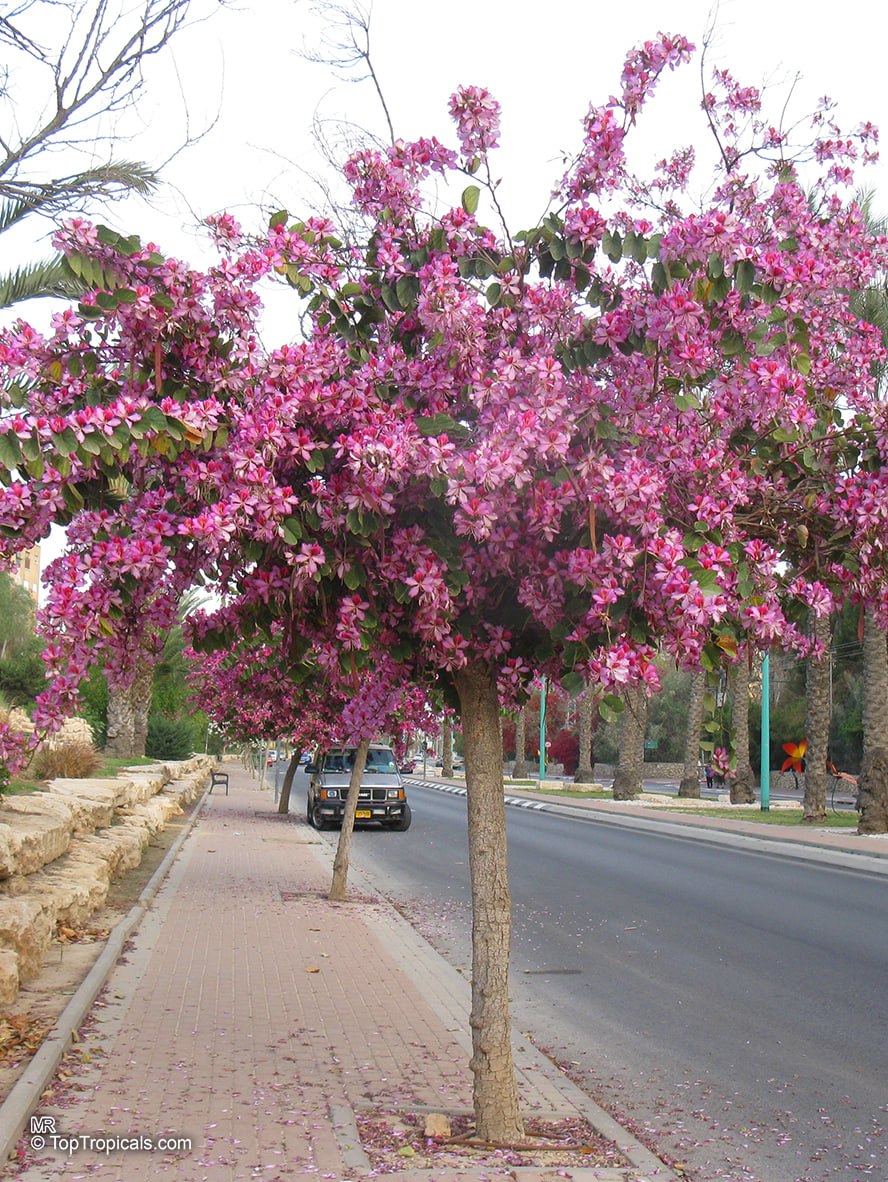
Bauhinia variegata, Pink Butterfly Orchid Tree
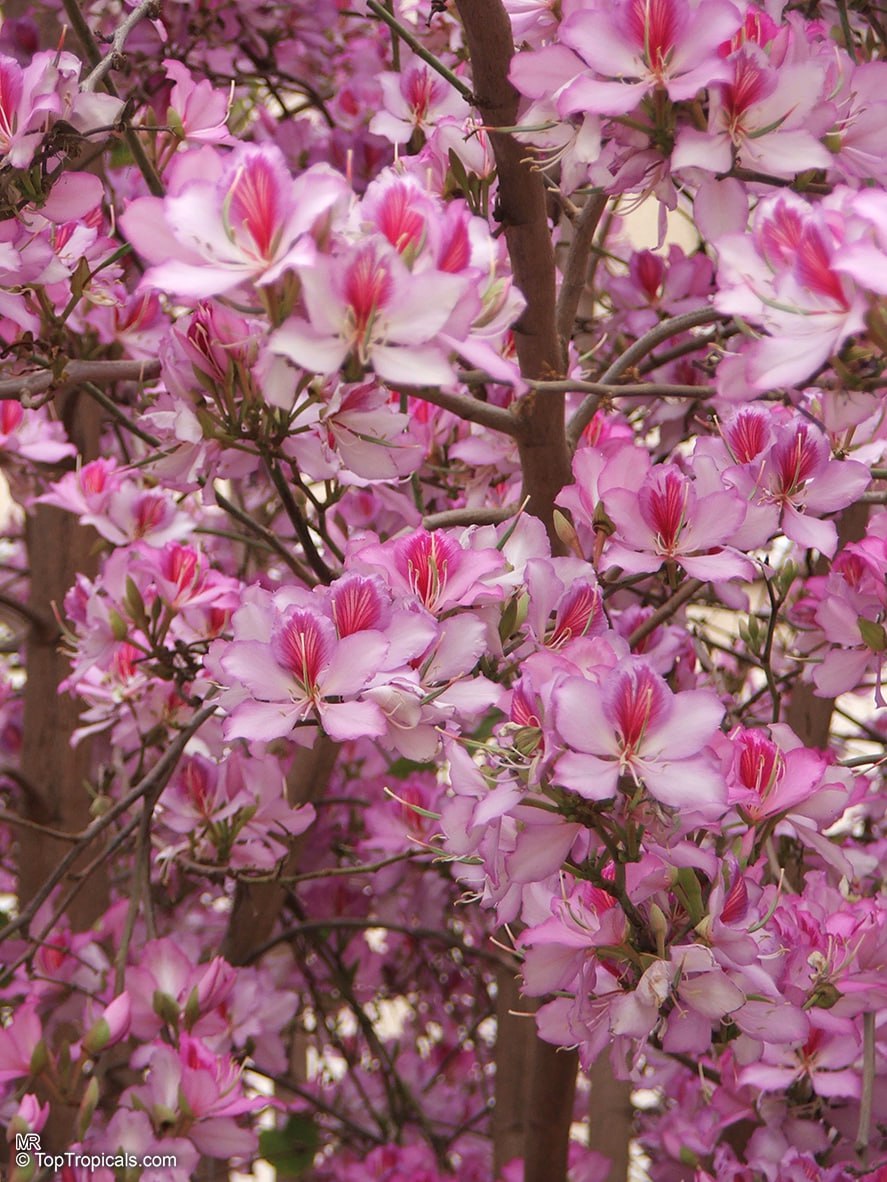
Bauhinia variegata, Pink Butterfly Orchid Tree, flowers close up
- 🌸 Bauhinia variegata, Pink Butterfly Orchid Tree - is a gorgeous, fast-growing tree with orchid-like blooms in shades of magenta to lavender. Flowers appear from late winter through spring - and sometimes again in summer - filling the air with a soft, sweet fragrance. Its butterfly-shaped leaves and wide canopy make it perfect as a focal point, shade tree, or street-side beauty. Great for sustainable landscapes, shelterbelts, and windbreaks too.
- 🌸 Easygoing and low-maintenance, it thrives in just about any soil - loam, sand, clay, even rocky ground - as long as it drains well. Loves full sun, needs little water once established, and grows fast (up to 2–3 feet per year) with plenty of cooling shade.
- 🌸 The bright blooms bring in butterflies, bees, and hummingbirds.
- 🌸 Extra bonus: its buds and blossoms are edible and used in traditional cooking, and the bark has been used in folk remedies for things like thyroid and ulcers.
- 🌸 Tough, fast, and blooming with elegance, the Pink Butterfly Orchid Tree is a gorgeous shade tree that thrives on neglect - poor soil, low water, no problem! Fragrant, orchid-like flowers light up your garden from winter to spring: easy to grow and even easier to love!
🛒 Limited stock - plant one this season!
Discover more Bauhinias - Orchid trees.
📚 Learn more about Orchid trees:
- ▫️Napoleons Plume - Orchid Tree that blooms in a pot
- ▫️How to grow Orchid Trees in pots
- ▫️Bauhinias: trees with Orchid Flowers and Butterfly Wings
- ▫️Why Bauhinias are called Orchid Trees: orchid flowers with butterfly wings...
- ▫️Bauhinia blakeana - Hong Kong Orchid Tree
- ▫️Bauhinia galpinii (punctata) - Pride of De Kaap or Nasturtium Bauhinia
#Trees
🟢 Join 👉 TopTropicals
Orchidantha maxillarioides
Family:Lowiaceae
Orchidantha, Orchid-flower
Orchidantha maxillarioides means "Orchid-flower", as one of the petals on the flowers is modified into a labellum, like the flowers of orchids.
Anacamptis pyramidalis
Family:Orchidaceae
Pyramidal Orchid
It is a good orchid to put into a meadow or wildflower lawn and usually thrives. Flowering takes place in late June through July. It also grows happily in a cold greenhouse, preferably in a plunged terracotta pot.
Ansellia africana
Family:Orchidaceae
Leopard Orchid
Ansellia africana, also known as the Leopard Orchid, is a striking epiphytic orchid native to sub-Saharan Africa. It forms large clumps of tall, cane-like pseudobulbs with long, arching leaves, and produces numerous yellow flowers covered with bold brown or maroon spots that resemble the pattern of a leopard's coat. These showy blooms appear in branching sprays and make the plant one of the most distinctive African orchids. The species is highly regarded for its dramatic floral display and the ability to thrive in bright light, often growing high in trees in the wild.
In cultivation, Ansellia africana requires warm temperatures, abundant light, frequent misting to keep aerial roots hydrated, and good air movement to prevent rot. It benefits from regular watering during active growth but prefers a drier rest period after flowering. This orchid is not frost tolerant and should be grown in USDA Zones 10-11, with protection required if temperatures fall below 50 F. Large plants adapt well to baskets or open containers that allow their extensive roots to develop freely, and they reward consistent feeding with impressive floral displays.
See detailed plant profile in new window: https://toptropicals.com/catalog/uid/ansellia_africana.htm
Arpophyllum giganteum
Family:Orchidaceae
Hyacinth Orchid, Bottlebrush Orchid
Arpophyllum giganteum, commonly known as Hyacinth Orchid, is a type of epiphytic orchid native to Central America. This small shrub typically grows to a height of 2 to 5 ft and thrives in USDA Zone 9-11. Its bright pink flowers appear in the spring and summer, with the single flower head up to 40 cm in length.
The Hyacinth Orchid will grow best when provided with semi-shade and moderate water. For those living in colder regions it can be grown in containers. Place the container in a spot where it will receive filtered indirect sunlight, potted in a well-draining potting mix and watered around once a week, making sure it is not left in standing water. Fertilizer, when needed, should be mixed in with the watering. Allow the orchid to dry out between each watering and maintain a temperature of at least 65°F. Taking care to not overwater, as this can result in the orchid developing root rot.
In summary, the Arpophyllum giganteum, otherwise known as the Hyacinth Orchid, is native to Central America and is an ideal houseplant for those living in USDA Zones 9-11. It is a small shrub, growing up to 2-5 ft tall and producing single flower heads up to 40 cm in length. When caring for, it will require semi-shade, moderate water, and temperatures of at least 65°F. Those living in colder regions should plant in containers and take special caution not to overwater. With the right care, the bright pink flowers of the Hyacinth Orchid will be sure to be brightening your home come spring and summer.
See detailed plant profile in new window: https://toptropicals.com/catalog/uid/arpophyllum_giganteum.htm
Arundina graminifolia, Arundina affinis, Bletia graminifolia
Family:Orchidaceae
Bamboo Orchid, Bird Orchid
The bamboo orchid, Arundina graminifolia, is a species of orchid and the sole accepted species of the genus Arundina. This tropical Asiatic genus extends from India, Sri Lanka, Nepal, Thailand, Vietnam, the Ryukyu Islands, Malaysia, Singapore, China to Indonesia, the Philippines and New Guinea. It has become naturalized in Reunion, Fiji, French Polynesia, Micronesia, the West Indies, Costa Rica, Panama... more
Arundina graminifolia is a terrestrial, perennial orchid with reedy stems, forming into large clumps. This orchid blooms in summer and autumn, showing rather open clusters of showy terminal flowers, ten at the most. They bloom in succession on the terminal racemes. These flowers are a rosy lilac and white disk with a purple lip. The bracts are wide triangular and surround the main stalk of the flower cluster. The occasional fertilized seed pods contain minute powdery seeds, and small plants often develop near the cane ends after flowering, and likely aid in propagation if allowed to reach the soil.
With only 200 of the plant to be recorded growing naturally in Singapore, the species is close to extinction there, largely caused by the destruction of its natural habitat, namely the rainforests and mangrove forests. The remaining plants, commonly called Tapah weeds, can be found in the secondary forests or at the forest fringes. It is however very common in road cuts and other disturbed areas in full sun in Sarawak, East Malaysia, where it often is the most common flowering plant to be seen along the roadsides.
Bamboo Orchid produces pinkish flowers at the top of tall cane-like pseudobulbs. It's the only species in the genus. The plants are quite tall; they'll reach at least hip level, possibly over your head, and their vegetative resemblance to bamboo can be uncanny. The long pseudobulbs have leaves alternating along their length, similar to Epidendrum orchids. The flower stems, which emerge from the top of the canes, produce several flowers sequentially, so that there will be one at a time over an extended period. The flowers are white with a purple-to-pink lip, and shaped similarly to a Cattleya orchid flower. They are 2-3 inches across, and can appear for much of the year, especially in summer.
Arundinas readily propagate themselves by keikis, which frequently develop along the pseudobulbs. Once a keiki has roots a couple inches long (several cm), you can carefully cut it off and pot it separately. The canes do not grow rigidly upright, they'll sometimes tip over; in nature, this allows the keikis to get established nearby, so it's a major vegetative propagation strategy for these plants; it helps them rapidly grow into large clumps. These plants like colonizing disturbed habitats, often growing as roadside weeds in much of Southeast Asia; being able to grow quickly helps them succeed in such places.
These plants are tough: they are quite robust and forgiving of less-than-attentive care. They are terrestrial orchids, so they like a denser potting mix than most orchids. It should still drain freely, however, and not be as dense as soil. A good starting point is equal parts sand, sphagnum moss, and fine fir bark. Bamboo orchids should be watered as they approach dryness; don't let them dry out too thoroughly. If you grow them outdoors, either if you live in a warm climate or if you just brought it outdoors for the summer, rainfall might water it often enough in some areas; but if it's starting to dry out water it thoroughly. If you grow orchids indoors, these plants are often too big to take to the sink; the easiest way to water will often be to dunk the pot in a bucket, then pull it out. Any aerial roots, such as on keikis, should be misted regularly. Fertilize regularly; the usual recommendation is to use a fertilizer especially formulated for orchids feeding weakly. Most orchid fertilizers are designed to be dissolved in the plant's water. They like high light: 2000-3000 footcandles is ideal, similar to the low end of Cattleya lighting. In nature, they commonly grow in direct sunlight. As long as the lighting isn't too dim you're probably fine. If it doesn't bloom, try increasing the lighting. You'll get the best results growing them at warm temperatures. It's OK if the temperature varies more widely than this; they can actually withstand mild freezes occasionally, though it's quite stressful for them. Any temperature that's reasonably comfortable (or a bit hot and muggy) for humans is going to be fine for bamboo orchids. They like good humidity, perhaps 70%, though this isn't critical. If the humidity is low, the plant should be misted regularly, especially if it has any keikis.
See video about Ground Orchids.
Close window
Bletilla striata
Family:Orchidaceae
Hyacinth Orchid, Chinese Ground Orchid
Bletilla striata is a perennial, deciduous orchid of open environments.
It is hardy in gardens from USDA Zones 5 (with protection) to 9.
Brassia sp.
Family:Orchidaceae
Spider Orchid
.
Brassia sp. (Spider Orchid) is a small shrub that typically grows 2-5 ft in height. It is a tropical plant native to Central America but can be grown in USDA Zones 9-11. This orchid is semi-shade loving and is an epiphyte, meaning it naturally grows attached to trees or other plants. The flowers of Brassia orchids are extremely unusual in color and can range anywhere from a yellow-green to a deep purple.
Besides its unique coloring, the Brassia orchid also attracts butterflies, hummingbirds and other pollinators from the nearby surroundings. Brassia sp. has a unique floral structure that consists of long and spreading tepals. This structure also helps attract pollinators, but at the same time it is a reminder of the watering needs Brassia orchids require.
When planting this species, it is best to plant the orchid in a well-draining medium. Good air circulation is also key to the successful growth of the orchid, as this prevents the leaves and roots from getting too wet and developing brown spots. When growing in a pot, it is important to use a pot with ample drainage holes, as this ensures that any excess water is quickly expelled. In cold regions, it is best to move the orchid to a sheltered position in the winter, preferably in a greenhouse or indoors.
Overall, Brassia sp. (Spider Orchid) is a unique and desirable tropical plant that adds a unique touch to any garden, especially for its unusual color and shape of its blooms. It requires a bit more care than other orchids, but with the right maintenance and care, this plant will provide you with weeks of glorious blooms.
Detailed plant profiles: 196 plants found
